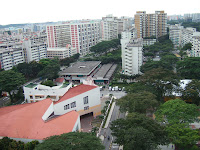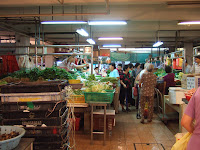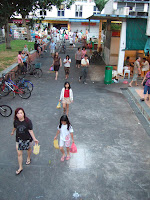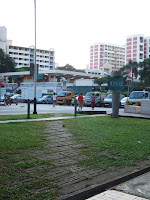I think this is a classic case of "One Man's Meat Is Another Man's Poison". 有人欢喜,有人愁。
The stall-holders are, of course, the most directly affected party. From what M has shared with us, many of the more elderly ones (who had literally slogged their youth away at this market for the 20-30 years of its operation) have opted to retire. Others have chosen to either take a break from this work (and take on some other temporary jobs to earn their living in the mean time) or relocate their businesses either temporarily or for good. A handful of the more fortunate ones who have sufficient savings to tide them over the rebuilding period without having to source for other income, have mentioned that they could do some travelling or grandchildren-minding during this time, too.
For regular market-goers like M, the options are quite obvious. The alternative markets that they can (and will probably have to) 'explore' now are relatively nearby. There is a 2-storey (but rather quiet) wet market at B37; there is another single-storey (but busier and more popular) one at GE. M prefers the one at GE because there is a better mix of stalls and the quality of grocery available there is generally better than that at B37.
I haven't been visiting the B89 Wet Market regularly these days. But I can easily empathise with those who are reluctant to see the aged 'old-style' market go. Afterall, I had spent many Sunday mornings during my growing-up years accompanying M to this market on her Sunday marketing trips, where she would 'buy more' grocery because 1) everyone would generally be at home for both lunch and dinner on Sundays; and 2) Mondays are the rest days of almost all of the market stall-holders.
Actually, for those Sunday marketing trips, it wasn't like we stayed the whole morning or entire afternoon at the market. In fact, the majority of those trips were much more brief than that the time we would typically spend doing grocery shoppng at the supermarkets these days. On average, each Sunday trip to the B89 Wet Market (including buying breakfasts of noodles or porridge or 面煎馃 etc) would take no more than an hour or so.
It was only during the pre-CNY period that M would need to spend a longer time picking up the freshest of fish, pork, poultry, vegetables and fruits etc because she had to 'stock up for CNY'. I remember that for those special 'heavy shopping' trips, it was a real challange to jostle for standing space amongst excited like-minded 'aunties', some of whom were armed with trolleys big and small (got to be extra careful not to be knocked by their trolleys!).
Many a times, M would be concerned for my safety (she was afraid that I might fall onto the wet, slippery floors or be scratched or knocked by the aunties' trolleys) and would instruct me to go wait for her at some specified corners/spots (which had more breathing space) whilst she made the purchases at the stalls. At times, I was only too glad to run off to these waiting corners/spots with the plastic bags of grocery already bought earlier (some aunties could be really unreasonable in their elbowing etc). Other times, however, I would stubbornly refuse to follow M's instructions because I also wanted 'a piece of the action' ('helping to choose' the vegetables or just simply watching how M went about selecting the pomfret or chicken also good, correct?!).
Despite the brevity of those trips and the frequent frustrations (of having to be 'sent out' to wait at the waiting corners/spots mainly because I could not 'out-jostle' those trolley-armed aunties), somehow, the memories of those marketing trips are very dear to me. They have a special place in me and I shall always cherish them. I guess we could call it my 'bonding time' with M in those days.
It was during those Sunday marketing trips that I learnt that to check for freshness of the fish, we should look to see if its eyes are clear; 'cloudy' or 'blurred' eyes are a tell-tale sign that the fish is no longer fresh. As for prawns, it is the 'crsipy-ness' of the prawns' shells and the firm-ness of the prawns' heads that indicate whether they are fresh; soft, slimy shells or loosely-attached heads show that the prawns' freshness has already been compromised. One more thing about prawns - we must not carry the prawns in the same hand as we carry food such as soya-bean milk or achar because the pointed, needle-like protrusion at the prawns' heads would almost certainly prick the plastic bags and the soya-bean milk will never find its way home and the achar will have been drained even before we reach the carpark.
I always found it a challange when we came to the butcher's stall because the aunties (M included) would rattle to the butcher the names of the various parts of the pig that they wanted to buy! There are so many different sub-parts/categories of ribs that even today, I remain clue-less as to what to tell the butcher - so I either point to what I want or I let the butcher know what dishes I need the parts for and the butcher will show me the parts suitable.
The B89 Wet Market had a big airwell right in its centre. This space used to be occupied by the poultry sellers who during the earlier years (until about 1990, I think) slaughtered their chickens 'live' in the market. I remember that this was the most stench-filled and noisy area of the market because not only would there by the aunties' haggling over which hens they preferred (the sellers would then reach into the the cages to get the selected hen), the terrified hens would be clucking away noisily in the cages. I don't blame the poor hens - who would enjoy watching their comrades go under The Slit by the slaughterer, right? Sigh.
After a while, this 'live' slaughtering practice was stopped. From then on, the poultry sellers sold only fresh chicken that had been slaughtered at some hi-tech, hi-hygiene (or so they say) slaughter houses. The air-well area was cleared of the cages and the spaces occupied by the poultry stalls were reduced to about half. The area became a holding area for various stallholders for their plastic trays/baskets etc.
I believe M also feels reluctant to see the familiar B89 Wet Market go. Afterall, this has been THE 'must-go' stop of her daily routine all these years. In a way, it has been to her what our offices are to us today.
But she also agrees that the market is old and it would be good to give it a new lease of life by having it rebuilt. So, I think she also looks forward to the new market that will replace the old, familiar one.
On a macro-level, it would be accurate to regard the B89 Wet market as the real community centre. Despite the lack of modern facilities (we still had only the stairs, new markets have ramps as well as lifts) and fanciful floor tiles that we see at some new markets, the B89 Wet Market had very much the people's Life and Soul. It was here that for good or for bad, the aunties and uncles would get together every day for their morning fix of coffee or tea and an exchange of the news and gossips of the what, where, who, when and how's.
On the 2 final days of the B89 Wet Market's official operational life, I armed myself with a camera and made my way there. My intention was to capture as much as I could, some images of this all-important venue before the bulldozers move in. What to do, a die-hard sentimental, cannot help it.
How silly I felt, however, when I went there because by this time, many of the stalls had already ceased operation and many were also in the process of being cleared out. About 80% of its usual bustle had gone. It didn't feel the same anymore.
(Lesson learnt: Never wait till changes have been announced before photgraphing the environment because usually by then, irreversible changes have already begun. Also, the scenes of the bustle on our annual special late-night trip to the B89 Wet Market on the eve of every CNY Eve to buy whatever 'last-minute' stock needed to tide over the CNY holidays, will now remain only memories to be cherished.)
Nonetheless, I managed to capture on the camera some marketing-actions (not quite the jostle I mentioned above but ok lah, just imagine a thicker crowd and some trolleys behind the aunties). I also snapped some shots of the various waiting corners/spots where M used to 'send' me to to wait for her.
Bird's Eye View - Day and Night, from our place.




M goes to market real early, about 6am. There was also a time when I would join her in the 气功十八式 exercise routine, but I stopped after a while because it felt a little awkward to be the youngest amongst a whole horde of aunties and uncles. Today, I still recognise some of the regular faces at these exercise sessions. The workout crowd is many times thicker than what is in this photo because most of the aunties had already gone to market by the time I took this photo!



Usually, M would proceed to the upper storey first. We usually climbed up the external staircase nearest to the bread stall (which was back-to-back with the laksa stall) and head for the fruits, followed by eggs (if needed) and then butcher and any dry-goods like dried shrimps etc. M has many friends amongst both the stallholders and customers at this floor. They would all call out to one another cheerfully and greet one another.
The elderly fruit seller (a jovial old Teochew man) had long been succeeded by his more grumpy son. Their stall was completely empty by the time I took the photo. The Indian man (the only Indian stall that I know at the B89 Wet Market) still faithfully ground his spices 'live' at his corner stall as I took the photo. M bought from him the appropriate concoction of spices for her various curries - chicken, ikan, vegetables etc.
The friendly aunty who sold coffee powder also sold a wide range of biscuits. R and I used to buy our supply of biscuits from her during our university days (for R's stay at the Temasek Hall). I am glad that I also brought WY and WF there every now and then. As is obvious here, the biscuits were completely gone by photo time.






This was the air-well. Forever bright and sunny. The cages and basins and basins of blood-stained water used for slaughtering the chickens are, of course, long gone. I would peer into the air-well from upstairs at times when waiting for M at the various waiting corners/spots upstairs. The slaughtering action as seen from upstairs would remind me very much of the women folk slaughtering chickens on festive occasions during our kampong time.




The butchers were also located upstairs. The stall that M usually patronised was the corner one manned by a scrawny old man. His equally scrawny son had taken over the business for some years now. They were always obliging when M (and later I, too) requested them to have the pork slabs rinsed under tap water before having them minced. This was one stop where I would almost always have to go to the waiting corner/spot because excited aunties would not leave any gap for small kids like myself to peer in at the display (last time, there was no chiller and so the meat was displayed openly on the table).


At the far end of the upper floor, there was a row of shops selling clothes, fabric, sundries like shampoo, talcum powder, toothpaste and sewing materials like needles, thread and the like. At one point in time, there was even a tiny aquarium that sold more wriggly worms than fish! By the time the photo was taken, all had been closed.
M would sometimes buy our shorts and t-shirts (I remember I had to replenish my supply of shorts quite often during my primary and secondary school days) from one of these shops. M would also buy some of her t-shirts there. While waiting for her, I would pause to look downstairs towards the food centre. I always found the roof of the food centre very interesting - there were so many layers of this black black slabs. I have no idea what they are called.







Once we were done upstairs, we would usually proceed downstairs at the staircase nearest the curry powder man. At this staircase (the drier of the 2 internal staircases), it was common to see one or two makeshift hawkers with their baskets of homemade/home-cooked food. On the morning that I took the photo, one aunty was there. She was offering some steamed yam kueh, I think.


The ground floor of the market housed the stalls selling the 'wet' stuff. Fish, vegetables, poultry, fishballs, 咸菜/achar, tofu etc. Extra care had to be taken when manouvering amongst the maze of the stalls. The 2 stalls offering cut flowers were also located there. The 'extra' row of display of vegetables displayed by one of the side stalls facing the food centre wasn't 'original'; it was a relatively new 'self-extension' from one of the side stalls.





The final stop would usually be the food centre. Usually, M would buy an assortment of breakfasts for us - prawn noodles, fried beehoon, fried carrot cakes, 九层糕, 面煎馃, porridge, 油条,butterfly firtters, mee siam, laksa (there used to be 2 rival stalls at one time, but only one survived to the end) etc. Mostly, M would vary the items each week, taking into consideration particular likes or dislikes of some of us. We usually would buy the warm soya bean milk, too.
Some of our old favourites had gone since long ago. I am not so familiar with some of the newer ones. But overall, the looks of the stalls had stayed about the same.
The morning I took the photos, I specially ordered a packet of fried carrot cakes (the 'black' one) from one of the few carrot cake stalls just so that I wouldn't feel so 不好意思 just taking the photo of the uncle at the wok. I also bought a total of $9.50 worth of kuehs from the stalls.








The various waiting corner/spots were usually just outside the boundary of the market. They were either at the open space near the laksa stall, or the space outside the 咸菜/achar stall facing Pipit Road, or the corner closer to the 面煎馃 stall immediately behind the porridge stall. At times, the marketing would become quite heavy and while waiting for M, I would place the plastic bags (we had to bring our own used plastic bags for marketing last time - in those days, it wasn't a practice for stallholders to supply fresh ones) on the ledge to rest my hands - see the elderly lady and her pandan leaves? It was somewhere there.
And of course, another main waiting corner/spot was the telephone booth just opposite the laksa stall. The design of the booth then was more traditional than that shown in the photo here.








On our way home, the stuff which M and I would carry would usually be so heavy that M would sometimes suggest that we take a break at the basketball court. So we would carefully rest the bags of vegtables, pork, fish etc on the stone benches without letting go of these bags. After the blood circulation on our palms came back, we would resume our walk back home.
I am happy that the stone benches are still around today. Same for the good, old basketball goal posts. As I snapped a few shots of the goal post, one old man came by and gestured a 'thumbs-up' to me. I guess he meant that it is good that I bothered.



*******************************
Demolition works started promptly within a day or 2 after the B89 Wet Market was vacated. By the following weekend, all the stall infrastructure, tables and stools were cleared out. Most of the black black slabs on the roof of the food centre had also been removed.


1 comment:
As with all things in motion, buildings and memories are slowly but surely being "destroyed" to make way for new things.
I feel sad when you described how heavy things were, when M and you carry them back from the market. It is a case of "blissful ignorance" for some of us, who thinks magically the food and drinks appear on the breakfast table, once we woke up. Thanks dear sister. I am ashamed to admit that I have never once accompanied our dear mother to the wet market, except for those exceptional "siao on" days.
The wet market will be gone. As with that, the memories.
The "cleanest hawker center" is also gone then.
Did anyone consult the residents on what the new building should be like? Any requirements or needs analysis?
Would there be a new sparkling multi-storey carpark? A mini-multi-storey shopping center where rents are high and therefore the prices high?
Everything in Singapore must go up, the oil prices, the buildings and also the food prices. All the way up up and away!
I am also sad to see the building go. Maybe it sounds quite unbelieveable, but as I type this, I really feel a sense of loss.
Wah.
Thanks for the photos. Maybe it will be wiser to print them out and put them in some kind of album. I am beginning to distrust this electronic medium and someday I will surely find my Harddisk corrupt or unreadable.
Better make back up now. Gigabytes are so cheap now.
Thanks for this blog entry.
Post a Comment